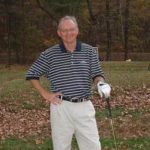Learn How to Hit Down on the Ball
Learning how to hit down on the ball... what in the world is supination?
Ok – first let’s define supination. Supination is basically just describing the fact that your lead arm rotates during the swing from a palm down to a palm up position. This is important because hitting down on the ball requires some shaft lean. Shaft lean without a little supination typically means the club face is open. Try this – get into your impact position with the shaft leaning, and a flat lead wrist. Is the face open? If not, you’re doing just fine! Watch the video here to understand a bit more about how to properly hit down on the ball!

The Nail Visual
I don’t like to use the term “Hitting Down” on the ball. Other issues could come out of that. I say, hit through the ball with a steeper angle of attack. Many times I can achieve this using a visual of hammering a nail through the ball. Keeping your eye sight slightly ahead of the ball. I would also place a tee an inch or two in front of the ball (left side of the ball for a right handed golfer) and have the golfer focus on hitting the tee, or popping it our of the ground. Look at the attached YouTube video for the “Nail Visual.”

Highland Meadows Golf Club, Ohio, Sylvania, OH
Really want to improve your golf game? Get incredible swing tips delivered to your inbox every week.
Get Your Ducks in a Row Early On for Better Strikes
This is a loaded question Backswing! But I’ll do my best to answer.
1) It is correct that a slight downward strike (what we call a negative Angle of Attack in the teaching world) is desirable anytime the golf ball is resting on the ground. This slight downward strike (in the range of 2-4 degrees downward) helps create solid contact in the center of the club face.
2) The lead wrist is a contributor in creating this negative attack angle, but so are other moves with the body and club. More often than not, if your lead wrist is breaking down before impact, it’s usually the result of poor body mechanics. Finding a good coach or PGA Professional can help you identify if this is the case.
3) While “supination” is actually rotation of the lead forearm counterclockwise (for a RH player), it can help create more flexion (aka: “bowing”) of the lead wrist. Together, these moves help square the club face and assist a player to hit downward slightly.
4) Here’s the catch: How much of this flexion (bowing) move a specific player requires depends on a few factors; a players’ lead hand grip being the most important. A stronger grip will require LESS flexion at impact to square the face and hit down, while a weaker grip will require MORE flexion of the lead wrist to square the face and hit down effectively. Again, working with a trusted coach to help you identify your grip and how much flexion you need is recommended.
ADVICE: Once you have wrapped your brain around how your lead wrist needs to flex and how much, the real secret to the sauce is actually being able to flex it the desired amount in a real golf swing at full speed. The biggest mistake I see golfers make is trying to flex the wrist at or thru impact. While the idea seems logical, the reality is by that point in the swing it is too late to try and implement the move. The club swings the fastest thru impact; trying to control it through wrist mechanics at this point is basically impossible.
I recommend the lead wrist flexion to happen much earlier, preferably in the transition-area of your golf swing, at the latest. Therefore, my advice is to get your ducks in a row early on so you can deliver the club at impact with better wrist conditions much more naturally and effectively at full speed.
DRILL: Get in front of a mirror and practice flexing your lead wrist the desired amount in early transition, the point in your swing when you change direction from backswing to downswing. Feeling a flexed lead wrist at this point helps simplify the rest of the downswing allowing you to deliver a square face and downward strike more often. After working in a mirror, go ahead and hit balls performing the same drill. I recommend pausing at the top of your swing to feel your wrist then swinging through at 50% effort to train the new move. Working up to full swings and more speed over time is the goal.
Avoid hitting on the collapse
Golf Professionals have many ways of instilling fundamentals into their teaching when working with beginners or high handicappers. However, many other players who have carded lower scores but still have the ability to improve fundamentals can benefit from a better understanding of the “Imperatives” as defined by Homer Kelley in the Golfing Machine. I do not recommend reading his book unless you have a big golf IQ. However, his imperatives and many of his other concepts are at the center of golf instruction!
Keep the imperatives in mind to improve Impact!
The Three Imperatives are:
1) a “flat” left wrist
2) a clubhead lag pressure point
3) a straight plane line
Employing the first imperative teaches the student to compress the golf ball when they make “ball first” contact.
Watch the impact position of a tour pro and you will see what I mean here. The lead wrist (left for right handed players) is flat through impact and then swivels a bit after impact to accommodate the grip end of the club leading the club head.
Any time the handle or grip end of the club is moving backwards while the head of the club is moving forwards the player has hit on the collapse and this should be avoided at all costs. It is commonly seen on practice tees across America; however, it is the death move in my opinion.
The grip/hands lead
I really am not a fan of the thought, “hit down on the ball.” The golf ball is struck three different ways depending on the club and ball position. Woods off a tee are hit with an ascending blow and are played near the lead leg heel. Woods and hybrids off the ground are hit with a sweeping motion, ball 1” back of lead heel. Irons with a descending blow, 2” back of same heel.
The key to hitting irons correctly is for the hands/grip to be in front of the club head, creating shaft lean and moving the bottom of the swing arc in FRONT of the ball. This creates a descending blow and a small shallow divot in front of the ball.
The problem most folks have is they try to help the ball up in the air. They do this by swinging the club head rather than the grip. This causes the club to bottom out behind the ball, the result is fat and thin shots.
Here’s a great drill to feel a descending strike. Draw a line in the turf about 2 feet long perpendicular to the target line, grab a wedge, NO BALL, set up with about 65% of the weight on the lead leg and leave it there. Take a slower pace take a half backswing, on the forward swing focus on swinging the hands/grip back down, club head lagging and try to brush the grass in front of the line. Keep doing this until you can do it every time. Then put a ball on a tee on the line and again, focus on brushing the grass in front of the line.
Drive Your Trailing Hip Up To Hit Down
Students ask me all the time…how do I hit down on the ball and take a divot? I always answer…why are you trying to do that…you will hurt yourself. The truth is that when a person is postured correctly their legs will work correctly.
Good posture in golf is similar to curling weights in the gym. If you push your backside out and reach with your arms in the gym while curling weights, your arms will pop out of socket. If you set up up with your elbows on your rib cage in golf like you would in the gym and grip the club, you will be correct. As you swing back your spine should should pivot in the same direction the clubhead is swinging. If that happens, then you will be in position to use your legs and drive your trailing hip up as you swing through the ball. That in effect will make the club hit down on the ball. You do not have to try and supinate your lead wrist or intentionally try and create lag. As you drive up and through the ball, the bottom of your swing will be in front of the ball and the clubhead will be descending down without you trying to hit down due to gravity and centrifugal force. In other words, hitting down on the ball is an effect of a good golf swing not a cause.
Get players to understand where the low point of the swing has to be
I definitely believe there is an easier way to try and do this without having to think so much.
I have always believed in trying to get players to understand where the low point of the swing has to be. If the ball is on the ground the turf interaction has to be on the target side of the ball.
Considering most right handed golfers are right hand dominant, trying to get them to focus on their non-dominant hand/wrist was almost impossible.
I have done a lot of work with the PGA HOPE Program, a golf program for Veterans and wounded Veterans. When I was able to get right handed golfers that did not have a left arm to bottom the club out on the target side of the ball, I knew it was possible for everyone.
During lessons I will have a full swing area with the ball and a full swing practice area next to the ball. In the practice area I will put a mark down, a line that signifies the ball. In their practice swing they have to bottom the club out on the target side of that line. It is something that most people can practice away from the range.
The key is to make sure you have a proper weight shift into the lead/front leg and then in essence feel like you are throwing the clubhead into the turf left of the mark/ball. You need to feel that first and then see what the divot patterns are like. If the divots are to deep we focus on trying to brush the ground target side of the mark/ball. The feeling is that the shoulders are staying on plane and the trail shoulder will cover the ball at impact.
By trying to obtain the low point of the swing on the target side of the mark/ball in this manner, it is a much less technical concept then tying to focus on pronation and supination.

Five Ponds Golf Club | Flagler Golf Academy, Warminster, PA
Forward shaft lean
Quite frankly, there are a number of movements that are related to physics that help us achieve a proper impact position. The first one is lag pressure, which is the natural lagging of the club as you move with weight shift and turn into the downswing. The second is centrifugal force, which helps you release the club as it attempts to fly away from you during the downswing, away from the center of the circle. Both of these actions happen naturally, as long as your hands and wrists stay soft throughout the motion. Any undue influence on the club can make you hit the ground too soon. As long as you shift weight and pivot into the downswing with your hands and wrists soft, you will get your ball first and then the turf impact!
Weight Shift for Proper Contact
We can talk swing plane, wrist action and many other thoughts on the golf swing to compress or strike the ball with a downward motion but to me it all revolves around proper weight shift. If you weight is shifting toward the target this will provide all the down strike you need in a golf swing. The shift and swing method also rotates your chest toward the target making your arms long enough for proper compression. Hold your finish after each shot and I guarantee your strike will be better. Good luck!!
Knuckles down!
In order to get into supinated a RH player should allow their arms to swing freely to the right ( don’t start your downswing with your shoulders or upper torso) while feeling that their left hand knuckles are turning down into the strike compressing the ball which should start slightly to the right of your target with a gentle draw bs k to your target. You may hsve to overdo this feeling until u get it.,, good luck!
How To Supinate In Lead Hand
I would have a client put a Golf Ball in there lead hand at hip high then go to impact then finish palm up so they can see ball toward finish side.
Forget it!
It can’t be done for the average player…Too difficult!
Grip Wins The Race
To hit down on the ball, rather than scooping, the grip of the club must pass the ball before the clubhead as you swing through the ball. Think of your swing like a bicycle wheel. Your hands are the hub, the rim is the club path, and the spokes represent the shaft. Where the spokes are angled to the rear from the hub, the rim is moving downward, and where the spokes angle forward, the rim….upward. So, if your hands go through the ball before the clubhead, your “spoke”, or shaft, is angled the correct way–to the rear– to assure a downward impact, assuming correct footwork.
Little Ball First, Big Ball Second!!
Having a descending blow in the ball requires the target side wrist to be flat or slightly bowed. But to simplify things, have the golfer concern themselves more with hitting the golf ball first (with a square clubface) and then the grass/ground after. The low point of the swing arc therefore is 3-5 inches on the target side of the ball.
It's all about timing and balance, get LEFT!!!
This one is real simple. Get onto your left side at impact, ( forward foot, right side for lefties), and the club will follow with a descending strike! If the sequence and timing are such, that the player is leading with a weight shift, or a lower-body move toward the target, the path of the club will be naturally downward, resulting in a solid ball- first blow, and divot to follow. This is the essence and basic timing for good ball striking. I don’t like or use the term “hit down: , as it implies to the novice to overuse the hands and arms to accelerate the club or “force” the shot. We should always think of timing and swinging the club toward a firm and stable front foot. A simple drill to experience the feel the proper impact sensation is to simply pre-set or plant 95% of your weight on the forward foot, and hit some smooth and easy 35 yard shots. In general, this is what all great ball strikers do!











